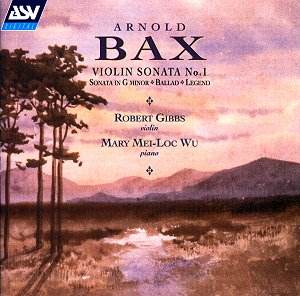Bax was musically prolific. Works poured from his pen
with generous profusion from his early teens until the mid-1930s. There
was something in his psychological make-up that made writing and invention
quite natural and this was intensified by the fact that the material
wealth of his family meant that distracting teaching or performing work
could be avoided. The hardening of his creative arteries hit him all
the harder when both productivity and quality began to falter and dry.
Not for nothing did he call his frustratingly incomplete autobiography
'Farewell My Youth' (the Ashgate version has Lewis Foreman's invaluable
annotations). When not lamenting the loss of youth or trying to recapture
it he called down hard curses on old age.
This is the second volume of the invaluable ASV two
part series. The series is welcome not only for the excellence of its
accomplishment but also because it starts and completes the work that
failed with the older Chandos recording of the first and second sonatas
(McCabe and Gruenberg). The Chandos disc should have been outstanding
(after all McCabe has been a lifelong Baxian repeatedly performing and
broadcasting Winter Legends, the sonatas and other solo piano
pieces and Gruenberg performed the Bax Violin Concerto at the Proms
in the early 1980s.). However the end results were curiously dry, artificial
and uninvolving.
The First Sonata is effusive, singing, full-lipped
and rapturous. Magically still moments are also to be found as in the
hooded contentment of the sighing epilogue of the last movement from
0900 to the end. While the First Sonata is alive with romantic feeling
which speaks more directly than Ireland and with less starry complexity
than Szymanowski, the single movement G minor sonata, written in his
fourth term at the Academy, has the genteel mannerisms of Macdowell
but already dowses these in romantic spirit quite beyond the Liszt pupil.
This can be compared with the brusqueness, almost aggression, of the
Legend which dates from February 1915 and which is informed both
by the anger of the times (a characteristic not be taken for granted
in works dating from the Great War years), by macabre visions and by
an enigmatic yet eloquent romance. The Ballad dates from 1916
and by its tragic tone probably reflects the death of friends (and of
dreams) in the Easter Rising. The piano part often echoes the sounds
and effects of the bardic harp. This is darker music than the ballad
episode in the first movement of the Violin Concerto (though listen
to 5.58) and perhaps has something in common with the dark-side reflected
in the powerful Second Northern Ballad (for orchestra). It is
strong on atmosphere but lacks the highest melodic qualities in the
Legend and First Sonata. The Ballad is a work in which
Bax communes most closely with himself, both magnifying emotions which
are close to lachrymose and applying balm and comfort. This together
with the Irish connection (with its overtones of intense privacy) explains
why the work disappeared until its revision and publication in 1929.
The notes are provided by Lewis Foreman, Bax's biographer
and long-time champion rivalled only by Colin Scott-Sutherland, with
the depth that comes of a lifetime's study and dedication to the Bax
cause.
I greatly admire the steady tone and sensitively imaginative
treatment that both artists bring to these works. Bax is well served
indeed.
Rob Barnett
MORE BAX ON ASV
Violin Sonatas, Vol. 1: No. 2 in D (1915, rev 1921); No. 3 (1927),
in F (1928). Robert Gibbs (violin), Mary Mei-Loc Wu (piano) ASV CD DCA
1098 review
Piano Trios: Bax, Holst, Stanford; Pirasti Trio. ASV
CD DCA 925 review


